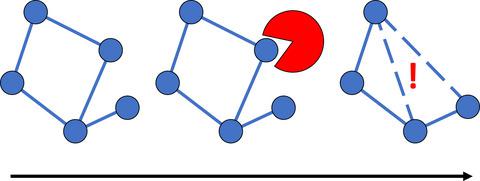当前位置:
X-MOL 学术
›
J. Anim. Ecol.
›
论文详情
Our official English website, www.x-mol.net, welcomes your feedback! (Note: you will need to create a separate account there.)
Structural trade‐offs can predict rewiring in shrinking social networks
Journal of Animal Ecology ( IF 4.8 ) Pub Date : 2019-12-02 , DOI: 10.1111/1365-2656.13140 Damien R Farine 1, 2, 3, 4
Journal of Animal Ecology ( IF 4.8 ) Pub Date : 2019-12-02 , DOI: 10.1111/1365-2656.13140 Damien R Farine 1, 2, 3, 4
Affiliation

|
There is growing evidence that organisms can respond to declining population sizes by adapting their interactions with others. Regulating connections with others could underpin resilience of biological networks spanning from social groups to ecological communities. However, our ability to predict the dynamics of shrinking social networks remains limited. Network regulation involves several trade-offs. Removing nodes (and therefore their connections) from networks reduces the number of connections among remaining nodes. Responding by forming new connections then impacts other network properties. A simple way to minimize the impact of up-regulating network connections is to form new connections, or to strengthen connections, between nodes that share a lost connection with a recently removed node. I propose a simple 'second-degree rewiring' rule as a biologically plausible regulatory mechanism in shrinking social networks. I argue that two individuals that have lost a connection with a common removed individual will both be more likely, or more willing, to form a new, or strengthen an existing, connection among themselves. I then show that such second-degree rewiring has less impact on important structural properties of the network than forming random new connections. For example, in a network with phenotypic assortment, second-degree nodes are more likely to be similar than any random pair of nodes, and connecting these will better maintain assortativity. This simple rule can therefore maintain network properties without individuals having any knowledge of the global structure of the network or the relative properties of the nodes within it. In this paper, I outline an algorithm for second-degree rewiring. I demonstrate how second-degree rewiring can have less impact than adding new, or increasing the strength of, random connections on both the individual and whole network properties. That is, relative to randomly adding or strengthening connections, second-degree rewiring has less impact on mean degree, assortativity, clustering, and network density. I then demonstrate empirically, using social networks of great tits (Parus major), that individuals that previously shared connections to a removed conspecific were more likely to form a new connection or to strengthen their connection, relative to other individuals in the same population. This study highlights how developing a better mechanistic understanding of the structural properties of networks, and the consequences of adding new connections, can provide useful insights into how organisms are likely to regulate their interactions in shrinking populations.
中文翻译:

结构性权衡可以预测缩小的社交网络中的重新布线
越来越多的证据表明,生物体可以通过调整与其他生物的相互作用来应对种群数量的减少。调节与他人的联系可以巩固从社会群体到生态社区的生物网络的复原力。然而,我们预测不断缩小的社交网络动态的能力仍然有限。网络监管涉及多种权衡。从网络中删除节点(以及它们的连接)会减少剩余节点之间的连接数。通过形成新连接进行响应然后会影响其他网络属性。最小化上调网络连接影响的一种简单方法是在与最近删除的节点共享丢失连接的节点之间形成新连接或加强连接。我提出了一个简单的“二级重新布线” 规则作为缩小社交网络的生物学上合理的监管机制。我认为,与被移除的共同个体失去联系的两个人都更有可能或更愿意在他们之间建立新的或加强现有的联系。然后我表明,与形成随机的新连接相比,这种二级重新布线对网络的重要结构特性的影响较小。例如,在具有表型分类的网络中,二级节点比任何随机节点对更可能相似,连接这些节点将更好地保持分类性。因此,这个简单的规则可以在个人不了解网络的全局结构或其中节点的相关属性的情况下维护网络属性。在本文中,我概述了二级重新布线的算法。我演示了二级重新布线如何比在单个和整个网络属性上添加新的随机连接或增加随机连接的强度产生的影响更小。也就是说,相对于随机添加或加强连接,二级重新布线对平均度、分类性、聚类和网络密度的影响较小。然后,我使用大山雀(Parus major)的社交网络经验性地证明,相对于同一种群中的其他个体,以前与被移除的同种共享联系的个体更有可能形成新的联系或加强他们的联系。这项研究强调了如何更好地理解网络的结构特性,以及添加新连接的后果,
更新日期:2019-12-02
中文翻译:

结构性权衡可以预测缩小的社交网络中的重新布线
越来越多的证据表明,生物体可以通过调整与其他生物的相互作用来应对种群数量的减少。调节与他人的联系可以巩固从社会群体到生态社区的生物网络的复原力。然而,我们预测不断缩小的社交网络动态的能力仍然有限。网络监管涉及多种权衡。从网络中删除节点(以及它们的连接)会减少剩余节点之间的连接数。通过形成新连接进行响应然后会影响其他网络属性。最小化上调网络连接影响的一种简单方法是在与最近删除的节点共享丢失连接的节点之间形成新连接或加强连接。我提出了一个简单的“二级重新布线” 规则作为缩小社交网络的生物学上合理的监管机制。我认为,与被移除的共同个体失去联系的两个人都更有可能或更愿意在他们之间建立新的或加强现有的联系。然后我表明,与形成随机的新连接相比,这种二级重新布线对网络的重要结构特性的影响较小。例如,在具有表型分类的网络中,二级节点比任何随机节点对更可能相似,连接这些节点将更好地保持分类性。因此,这个简单的规则可以在个人不了解网络的全局结构或其中节点的相关属性的情况下维护网络属性。在本文中,我概述了二级重新布线的算法。我演示了二级重新布线如何比在单个和整个网络属性上添加新的随机连接或增加随机连接的强度产生的影响更小。也就是说,相对于随机添加或加强连接,二级重新布线对平均度、分类性、聚类和网络密度的影响较小。然后,我使用大山雀(Parus major)的社交网络经验性地证明,相对于同一种群中的其他个体,以前与被移除的同种共享联系的个体更有可能形成新的联系或加强他们的联系。这项研究强调了如何更好地理解网络的结构特性,以及添加新连接的后果,



























 京公网安备 11010802027423号
京公网安备 11010802027423号